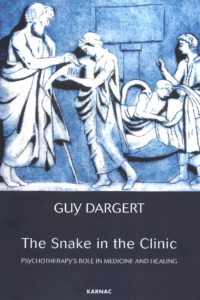
Guy Dargert, The Snake in the Clinic: Psychotherapy’s Role in Medicine and Healing. London: Karnac, 2016
Reviewed by Dr Jane Slater
The best review of a book is unlikely to be written by an enthusiast, so I need to confess upfront that this book blew me away. The first time I read it, I entertained passersby with involuntary exclamations of “ Yes” and “ That’s SO true”, and even on one sublime paragraph, “ Go Guy”. Thus, my first task was to rein in my paeans of praise and attempt to be objective.
In titling the book The Snake in the Clinic, Dargert refers to the snake coiled around the staff of Aesclepius, the god of healing, a symbol used by the British Medical Association. The book reminds us that in the age of the serum rhubarb, scans for everything and a pill for every ill, we forget at our peril the crucial role of simply understanding what an illness is doing for us. The wisdom of the ancients deserves review and benefits our patients and ourselves, cutting through the fog of technology into which modern medicine risks becoming lost.
The Snake in the Clinic is an overview of the art of healing, bringing together strands of orthodox clinical medicine (p.45, illness being the opposite of health) with various psychotherapeutic philosophies, and interweaving them with ancient understanding of the purpose of illness (p.142, dancing with illness). Indeed, the whole premise of the book is to re-jig our concept of illness from something to be avoided and fought (p.40, the War on Cancer) to a gift: the illness itself can bring an opportunity to heal or make whole some broken area within us (p.46, Jung’s thoughts). Dargert even takes us to the ultimate with his question, “Can there be a healthy death?” (to which the medic’ asked responded, “A young fit man in an RTA?”). Along with all GPs, I have been privileged to have seen many a ‘healthy death’ over the course of my career – patients wholly at peace with themselves at the end.
Dargert questions our very concept of illness and wellness, contrasting the WHO definition of health as an absence of disease with the idea of health as a state of equilibrium, a balance between so many factors in our lives that are at odds with one another: the pressure to conform and to live up to expectations versus the wild spirit wishing a different path. He gives numerous examples from patient encounters to illustrate his points, which was valuable in cementing my understanding of sometimes alien ideas.
Dargert draws on Taoist, Buddhist, tribal religions and the concept of the Daimon (so well realised by Phillip Pullman in his Northern Lights trilogy as the connection between the physical body, mind and spirit) to exemplify his holistic approach. There are also explorations of dream material as a bridge to the unconscious, holding vital keys to those physical and psychological problems seeking solutions.
He is unafraid to quote his detractors, such as Susan Sontag’s rant against the use of psychotherapy in the treatment of cancer, though hers seemed a misplaced criticism of what psychotherapy could achieve: it seeks not to get rid of the disease or symptom, but to understand what it may offer, and through this understanding find an acceptance and an ability to fully live despite the condition. Whilst encouraging the use of all available therapies and not abjuring the more physical medical approach, Dargert rather seeks to balance and complete the process of achieving wellness by simultaneously exploring the effects of the dis-ease on the soul or psyche. If ever I were to need the aid of an oncologist, I hope to find a Guy Dargert character in the wings helping me to interpret and make sense of what it all means to me and my life. We’re around for so short a time, it behoves us all to be proactive in looking for meaning for ourselves and our patients before our little lights are snuffed out.
To combine erudition with readability is a skill indeed, and Dargert displays both with humour and an infectious sense of questing which comes only from a therapist and pedagogue brimming with life. It is well researched, engagingly composed, and absorbing. I would love this book to be a set text for GP registrars, and indeed would commend it both to those in the business of healing and those requiring of the same.
My only criticism is that I couldn’t find it as an audio book – listening in the car between visits and clinics is one of the few “ breaks” one has these days. But it is a good bedtime read also.
Who knows what you might dream…